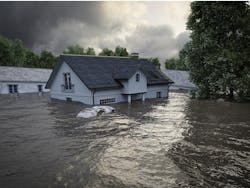FEMA Offers $500M in Resilience Grants. An Opportunity for Microgrids & DERs?
The US Federal Emergency Management Agency (FEMA) has announced a $500 million infrastructure grant program that offers opportunities for microgrids, energy storage, backup power, and other advanced energy solutions.
Through the Building Resilient Infrastructure and Communities (BRIC) grant program, the agency seeks infrastructure projects that lessen risk for disaster, reduce disaster losses and immediate threats to public health and safety, and augment rapid recovery efforts. Those eligible to apply include states, local communities, tribal governments, and territories.
By 2M media/Shutterstock.com
FEMA will make $446.4 million available through a national competition, with a cap of $50 million per project. States and territories can also apply for $33.6 million in earmarked funding; $20 million will be set aside specifically for tribal governments.
This year’s application period opens September 30
A separately funded program has also been announced that focuses on mitigating flooding risk. But beyond flood resilience and mitigation, the BRIC program’s broad objectives and open, nationwide competition make an array of resilience solutions, big and small, eligible for funding. Grants can be used for capacity building activities, management costs, and tangible assets to enhance resilience.
Grant recipients must share the costs — generally 75% federal and 25% applicant. The portion from grant winners can be cash, in-kind or donated services, or necessary materials, as well as equipment. Impoverished or particularly vulnerable communities and remote populations are eligible for a reduced or even eliminated cost share, depending on certain criteria.
FEMA has found ‘pre-disaster mitigation strategies’ — infrastructure that avoids or reduces risk — to be critical in reducing the impact and disruption of increasingly common natural disasters. Since 1980, the US has suffered through more than 200 natural disasters that exceed $1 billion in damages. FEMA has a number of case studies and success stories that demonstrate the effectiveness of investments in mitigation and resilience initiatives.
The legislation that authorizes the funding requires that states, tribes, or territories have received a major disaster declaration under the Stafford Act within the last seven years; in a bit of a mixed blessing, all states and territories currently qualify.
Throw me a lifeline
The BRIC program is a key component of FEMA’s strategic plan and national mitigation investment strategy. To win funding, the initiatives must be cost-effective (under FEMA’s cost-benefit scoring) and designed to increase resilience and reduce risk of injuries, loss of life, and damage and destruction of property, especially for critical services and facilities.
Earlier this year, microgrid companies urged the agency to give weight to applications that mitigate risk to multiple ‘lifelines.’ The agency did so in its scoring criteria, brightening prospects for the microgrid projects and initiatives. FEMA defines community lifelines as “fundamental services in the community that, when stabilized, enable all other aspects of society to function.”
FEMA scoring
Lifelines are a major focus of the agency and represent 15% of evaluation scoring. Microgrids, in particular, can mitigate risk to multiple lifelines and ensure continuity for critical facilities and operations. Microgrids for hospitals, emergency services, and government facilities all suit this criteria. Additionally, in sustained emergencies and recovery from natural disasters, other facilities like grocery stores, gas stations, cell phone towers, and even banks become increasingly critical to the health and safety of the public.
Solutions that are able to augment multiple lifelines in tandem — like a community microgrid that backs up a mainstreet district and local government operations — could significantly improve applicant scores in this category in the national competition.
FEMA also gives significant (10%) scoring weight to “nature-based solutions,” which in their flood mitigation programs include objectives like wetland restoration or protection and expansion of greenspaces. This broad categorization has implications for project design and implementation. FEMA also encourages applicants to “consider high winds and sea level rise” when developing resilience solutions. Together, these objectives acknowledge worsening climate conditions throughout the nation and the impending impact to resilience on our aging infrastructure.
Help is available
FEMA’s scoring systems tend to be notoriously complex rubrics that attempt to reflect the diverse array of communities they hope to serve. The agency has a number of resources available to help applicants navigate this funding opportunity.
Anyone interested can join for a webinar that will be hosted by FEMA three times this month: August 18, 20, and 25, all 2-3 pm ET. Tribal applicants can participate in a dedicated webinar on August 27, 2 pm ET.
FEMA also will host a webinar on common pre-disaster mitigation grant application errors and how to avoid them on Sept 1 and 2.
The programs broad objectives and criteria leave the door open for a number of creative solutions to increase infrastructure resilience and protect the health and safety of the public. By authorizing these funds FEMA “hopes to strengthen our nation’s ability to build a culture of preparedness by reducing disaster losses and protecting life and property from future disaster damages”. Microgrids and resilient energy infrastructure can be a key component of that mission.
More information on the BRIC program and resources are available here.
Matt Roberts is Director of Strategic Growth & Government Affairs.
